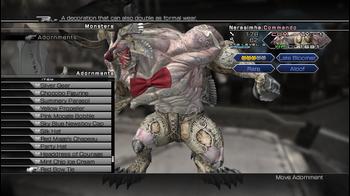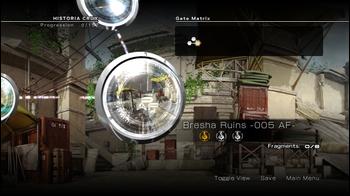
Testing Final Fantasy XIII-2's New Features
We've know about the new additions to FINAL FANTASY XIII-2 for months, but it's impossible to know how these changes will fare based on trailers or short demos found on the show floor at places like E3 and Tokyo Game Show.
Square Enix were kind enough to give us more extended time with FFXIII-2, though, and now that I've had significant hands-on time, I've come around to some things I didn't think I'd like and found myself irked at bits that seemed cool. So, which of the game's much-touted new features are good and which ones aren't quite so good? Here's my take.
Cinematic Actions
FINAL FANTASY XIII-2 begins in Valhalla, where Lightning fights Chaos Bahamut, a giant red-eyed mecha-ish take on one of the series' most-loved Summonables. Lightning is saved by Odin, leaving the rest of the fight to take place on horseback. Although the scenery is on an epic scale and look really cool, your character is on a track the entire time and the fight is fairly straightforward - it's the first introduction to the battle mechanics, after all.
The most interesting addition to this battle is the cinematic action choices. Although we’ve seen cinematic actions in past demos, such as in Noel’s fight with Atlas, those seemed more gimmicky, like a nagging reminder for audiences to participate during cut scenes. Cinematic action choices make sense – you are still “fighting” Chaos Bahamut, but you can choose at a particular point to use a sword or a gun.
Sometimes it seems to be a merely cosmetic choice – Lightning pulls out a sword rather than a gun. But other times there are obvious positive or negative repercussions – if you fail to dodge an attack, you take damage additional damage. The choices made in the cut scenes will impact the boss’ HP level after the battle. The choices in this particular battle let you choose between attacking and using magic, as well as between using gravity and using your gun.
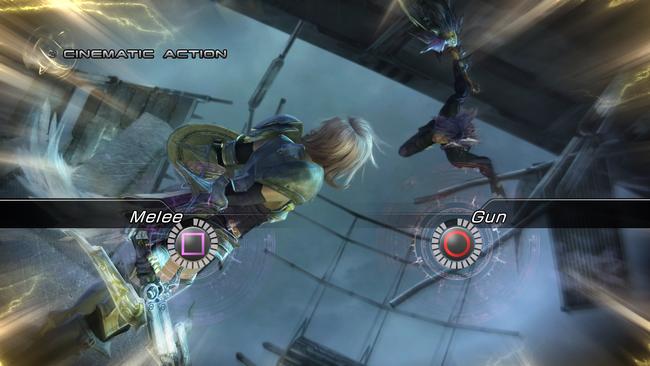
Verdict: Success! I initially hated these, but the choices have won me over. Much better than some other titles like Assassin's Creed, where cutscenes sometimes require you press B once in a while to show you’re still paying attention. It gives you a reason to get into an action-packed scene.
Live Triggers
Episode 1 is titled "A World Without Cocoon" and takes place in New Bodhum. Serah wakes up from a dream about Lightning’s epic battle. At this point, there's the perfect example of how the new 'Live Trigger' system is used. When Serah wakes up, you can choose between wondering if it was just a dream, if it was a message from Lightning, or pondering the strangeness of Lightning’s clothes.
Next, you walk outside and are faced with a second live trigger: "Is everything I remember a lie?" "Have I died?" "Is this still a dream?" "Is this the future?" This shows the nuance of the options; this isn't a game from Bioware like Mass Effect, which has distinct categories of responses, but corresponds to specific dialogue. Your choices are immediately reflected in Serah’s dialogue after the live trigger, but the rest seems to be stock dialogue.
Sometimes the nuances are a bit too subtle for me to really care, like in the second live trigger: "Where’s the village?" "Everything out here is different?" "What’s this place?" The difference here is hard to really tell or care about.
There are also a lot of live triggers where I wish I could choose multiple dialogue options. After Noel Kriss shows up, Serah has a few options of what to say to him: "Where are you from?" "Did you really see Lightning?" "You’re a hunter?" I want to ask all the questions, but I only get to choose one and have to hope the rest get answered somewhere later down the line.
The first time that the live trigger choices seemed potentially useful was in the interaction between Noel and Gadot. There were a few ways you could have Noel respond to Gadot’s distrust and reassure him that you have Serah’s best interests at heart. I asked if there was any way you could make Gadot trust you at this point at the game, but regardless of what you choose, Gadot remains angry. Later in the game, Gadot will eventually come around, but I don’t think it depends on live trigger choices.
Verdict: At least in the beginning of the game, it’s frustrating that these live trigger choices don’t impact more than the dialogue. But if these choices do end up impacting either character relationships or the multiple endings, then this feature can be redeemed.
Moogles
Moogles are back and as adorable as ever. In a dramatic scene, Lightning gives Noel a purple crossbow to give to Serah, but the crossbow can also transform into a Moogle companion. FFXIII-2 is fairly heavy-handed in its introduction of the item-finding abilities of your pet moogle. In the game, you can discover fragments, which are memories lost in time. There are 160 fragments to discover in the game and you can see how many you have left in each section on the historia crux page.
You must find artifacts to fix time, which are usually represented by anachronisms and are used to open various time gates. Fortunately, you have a moogle friend who gets really excited when he’s near an artifact. The first one you discover is Lightning’s knife. Your discovery sparks a cutscene and shows an alternate timeline.
The second artifact you look for is Snow's necklace. A young boy in Serah’s class, Rhett, has stolen it. (This time the live trigger system demonstrates what happens if you choose wrong – new dialogues open up.) This process repeats a few times over, to the point of tedium, but the adorable plot-relevance mostly makes up for it.
Additionally, moogles can unlock items that are in different timelines, that show up as a faint outline in an area. Once you gain the ability through a minor plot point, you can press a button for your moogle to magically bring the item into your reality.
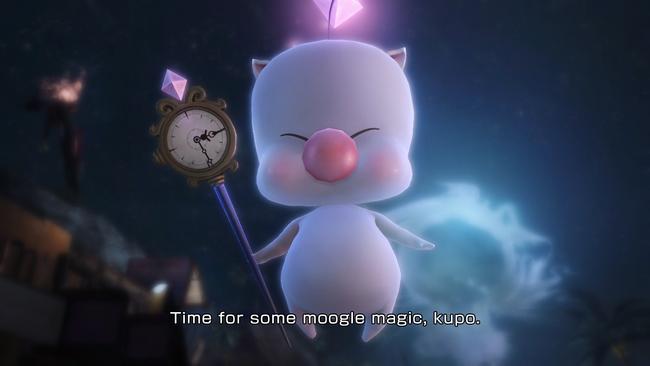
Verdict: Cute as it is, I prefer the item-finding dog in Fable, which at least is over quickly. Items that I can see but can't get for some reason or another really bug me.
Monster Capture
We also got a chance to see the full monster battling system. When you defeat an enemy in a random battle, you earn monster crystals. These crystals can be used to put these monsters into your party. This is a great way to round out a two-person party, such as Serah and Noel.
Because my party lacked a medic, I recruited Cait Sith, who regularly cast cure on Serah and Noel, but over 150 monsters are recruitable including FF favorites like the Tonberry, Chocobo and Cactaur as well as other familiar FFXIII enemies right up to the massive behemoths that were such regular foes in the original game. It's worth noting the Cait Sith in question is not the doll from FFVII, but the traditional legendary cat.
As you battle as well as performing whatever moves are at their disposal, the Feral Link bar for that monster will fill up. Once full, you can unleash your recruited monster’s special attack. Each monster's special attack requires some kind of player interaction in the form of a cinematic action, and failing to input the command will result in a failure to do as much - or any - damage. Like cinematic actions, your ability to hit X repeatedly is critical.
Cait Sith’s Feral Link move is Kitty Clock, where he jumps out of his floating case and punches the enemy. You can even accessorize your recruited monsters to distinguish them better from their untamed counterparts with stuff like sunglasses and other equipment, as as mentioned in our full gameplay preview they have their own version of Crystarium for progression.
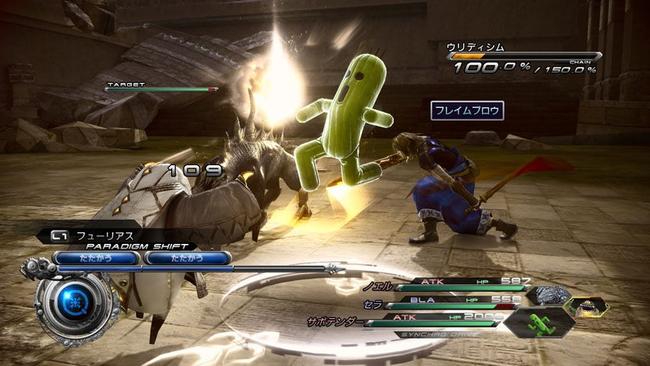
Verdict: I love Cait Sith. I thought this would be gimmicky, but there are so many potential combinations for paradigms with hundreds of monsters. Because the game is all about balancing various roles, this surprisingly is a nice addition.
Mog Clock
Mog clocks are a visual way of representing what type of stead you're going to enter battle in. Rather than just have you watching an enemy's animation and trying to get behind an enemy that's already noticed you to initiate a 'Back Attack', the Mog clock shows you what's going to happen when you enter a battle in pretty straightforward terms.
The clock appears below your party leader and has three different settings - green is good, yellow is neutral, and red is bad. If you’re going to engage in battle, it’s best to go for it on good terms.
Once things start slipping into the red, I typically just run away and re-initiate the enemy at a later time. Escaping battles is easy, and just a matter of running outside of an enemy's circle of sight until they lose interest and turn away once more. In the early stages of the game seems like a very easy system to game and cheat to have every battle be one you enter in positive stead.
As well as giving you a first-attack bonus, pre-emptive strikes in FFXIII-2 also reward buffs right from the start of battle, meaning you can start a battle with haste or an attack buff already in place.
Verdict: Because it’s so easy to escape battles, it’s mostly a non-issue. You can typically manipulate the mog clock to get an early advantage.
Historia Crux
The historia crux system is one of the major revamps of FFXIII-2 and it opens up the world in a way that wasn’t previously possible. When you open a time gate with an artifact, you’re able to travel to a new time and place.
There are a whole slew of diverse landscapes: jungles, temples, futuristic cities, snow-covered landscapes and destroyed ruins, and rather than guide you through them in a truly linear fashion FFXIII-2 instead plops you into Historia Crux and let you choose where - and when - you want to go.
Not only can you play through the matrix gate in any order, but you can replay chapters as well. In fact, the game rewards multiple play-throughs and provides different ways to do so. You can return to an area to find more items and gates. You can go back to complete subquests that you might've missed or couldn't complete, and doing so might weaken bosses that you'll fight later on.
In a very interesting first for a core FINAL FANTASY title, you can also rewind time and play through an area again as though it’s your first time, righting things that went wrong the first time through. The comparison to Square Enix's other time travel Epic, Chrono Trigger, are obvious, but while time was core to the plot of that game and didn't have all that many gameplay impacting moments, here it appears to be linked to both the gameplay design and plot of the game to its very core.
Verdict: Replaying sections isn’t my personal gaming style, but for those 100% completionists out there, this feature is for you. It definitely keeps the game from being linear and gives players a lot more freedom than the last game.
That's your lot - for now. If you want to read more about FFXIII-2, be sure to head to the game page for interviews, previews, news and more and the Media Vault for Screenshots, Videos and Artwork from the game.
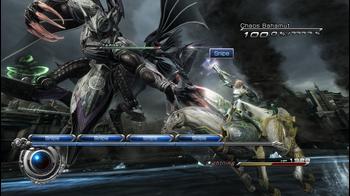
_04_RGB.jpg)

